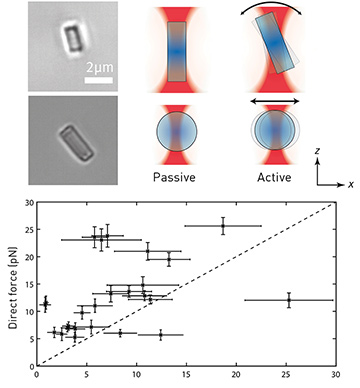 Top, left: Zeolite-L crystals observed from the side. Top, right: Schematic side view of cylinder and sphere in optical traps. Passive: resting probes; active: probes driven through viscous media, causing displacement and torque (visible as rotation of the cylinder). Bottom: Comparison of direct force sensing with Hooke’s law. Direct forces are above the unity line, indicating the presence of rotation. [Enlarge figure]
Top, left: Zeolite-L crystals observed from the side. Top, right: Schematic side view of cylinder and sphere in optical traps. Passive: resting probes; active: probes driven through viscous media, causing displacement and torque (visible as rotation of the cylinder). Bottom: Comparison of direct force sensing with Hooke’s law. Direct forces are above the unity line, indicating the presence of rotation. [Enlarge figure]
Optical tweezers have revolutionized the field of micromanipulation, establishing themselves as a reference tool not only for optical trapping but also for force sensing.1 Optical forces exerted by the tightly focused beam are in the range of cellular forces, enabling accurate, fast and flexible force estimations in biological systems. The success of such piconewton force measurements relies on state-of-the-art methods for trap calibration, such as active-passive calibration based on Hooke’s law or momentum calibration for direct force sensing.
All of these calibration techniques for force sensing, while well established, employ isotropic—that is, spherical—particles as basic sensors. There is a growing demand to extend force sensing to anisotropic biological probes, which could reduce heat damage caused by the optical trap and guarantee biocompatibility for in vivo experiments.2 The possibility to calibrate an optical trap beyond spheres has not been fully explored.
In this work, we experimentally demonstrated the use of cylindrical biocompatible microcontainers, Zeolite-L crystals, as probes for force sensing. We showed that anisotropic probes can be accurately calibrated with available methodology by comparing passive calibration with direct force measurements.3
We found no differences in forces based on Hooke’s law along both transverse directions, despite the common linear polarization of optical tweezers. Furthermore, these forces agreed with those calculated from Stokes drag, assuming constant drag and an approximated Stokes drag coefficient for the cylindrical Zeolite-L probes. However, the comparison of these calculated forces with our novel method of direct force sensing revealed additional optical forces which cause the elongated probe to rotate. According to simulations, this rotation is due to torque.4
On one hand, our results demonstrate accurate force sensing with anisotropic probes, and the importance of quantifying rotation, torque and the related optical forces. On the other hand, the use of Zeolite-L crystals, not only as drug carriers or building blocks but also as force sensors, makes them ideal probes for biological systems.5 We believe that these findings broaden the impact and capabilities of optical tweezers, providing far-reaching insights into the field of optical force metrology.
Researchers
Robert Meissner, Neus Oliver and Cornelia Denz, Westfaelische-Wilhelms-Universitaet, Muenster, Germany
References
1. N.I. Petridou et al. Nat. Cell Biol. 19, 581 (2017).
2. S.H. Simpson et al. J. Quant. Spectrosc. Radiat. Transfer 146, 81 (2014).
3. R. Meissner et al. Part. Part. Syst. Char. 35, 1800062 (2018).
4. A. Farré et al. Opt. Express 20, 12270 (2012).
5. Á. Barroso et al. Part. Part. Syst. Char. 35, 1800041 (2018).
